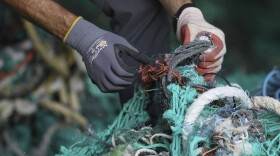Museums and archives are often celebrated as rich repositories of culture and history. But for the communities whose culture and history are on display, having a say over what should become of these items is an ongoing battle – one that some native Hawaiian advocates and scholars are tackling head on.
Halealoha Ayau has spent decades hunting for native Hawaiian remains and sacred objects in museums around the globe. His group, Hui M?lama I N? K?puna O Hawai?i Nei, helped repatriate feather cloaks, wooden statues, and more than 6,000 ancestral bones in the past 30 years.
“So the good part is that our ancestors are coming home,” says Ayau, “The bad part and worse part about this problem is we will never know how many k?puna are out there.”
Ayau joined scholars and museum officials to discuss broadening the role of indigenous communities in museums at this year’s American Studies Association Convention in Honolulu. The session, titled "Decolonizing Museums," took a deep dive into the ways in which museums are responding to national and global calls to decolonize. Returning objects to the communities of origin are one option.
Native Hawaiians like many indigenous communities have no records of when, why, or how cultural items left the islands. Museums, however, work very hard to ensure everything they’re holding has a legal right to be there. Ben Garcia, director of the Ohio History Collection, says museums may have a high legal standard but often lack an ethical standard.
“The piece that museums are not required to look at is how items or belongings or ancestors left their communities,” says Garcia. “With a focus on how [items] came into the museum rather than how [items] left, you miss a really important part of the history, which was the part where separation happened.”
H?lena Kapuni-Reynolds, an American Studies graduate student at University of Hawai?i at M?noa, says he’s searching museums and archive collections for old photos and documents taken from his hometown of Keaukaha on Hawai?i Island. For his dissertation, he plans to document exactly how these items left.
“Nui ?ino n? palapala kahiko i m?lama ?ia ma k?ia mau wahi ak? ?a?ole i maopopo paha ke kai?ulu ma hea l? ia mau palapala,” says Kapuni-Reynolds. He says there’s a large repository of old documents in these archives and the community may not even know they exist.
Kapuni-Reynolds believes the ancestral wisdom and place-based knowledge stored in these documents are an invaluable asset to the strong native Hawaiian community of Keaukaha. He says returning these items to the community will help strengthen the community's sense of self and sense of place.
But reconnecting indigenous people with items originating from their community may mean museums lose possession. It’s something Noelle Kahanu says requires a shift in how museums relate to communities. Kahanu works at UH M?noa’s American Studies Department.
“There’s a perception that there’s a loss, that they?re giving up something,” says Kahanu. “When museums are ceding authority that can build relationships between communities and museums in a way that can really last for generations and be transformative.”
Rather than "ceding authority," Kahanu and others on the panel use the phrase "seeding authority" to convey a generative sense of growth. But all of this theoretical talk has her eager for action.
"What does that mean on the ground?" says Kahanu. "What does it mean when the San Diego Museum of Man locks down their archives and says, 'Unless you can show us that you have consent from the community that you're studying, we're not going to grant you access to photographs, to field notes from that community.' I mean that's so simple and yet really transformative."
Garcia was deputy director of the San Diego Museum of Man when these changes were being made. He says for museums, this means including perspectives from communities that were not historically included before.
“Allowing the people who have the greatest connection to the things in museums the ability to decide what happens to them,” says Garcia.
Repatriation advocate Ayau says he’s not waiting for the museums to come around. He spends most of his free time looking up museums around the world and emailing them to see if they have any native Hawaiian remains in their possession, a time-consuming yet fruitful undertaking, he says.
He's headed for Germany in the coming months to retrieve a mea kapu or sacred object -- a carved wooden statue of the goddess Kihawahine -- one of the most sacred he’s ever sought to return.




